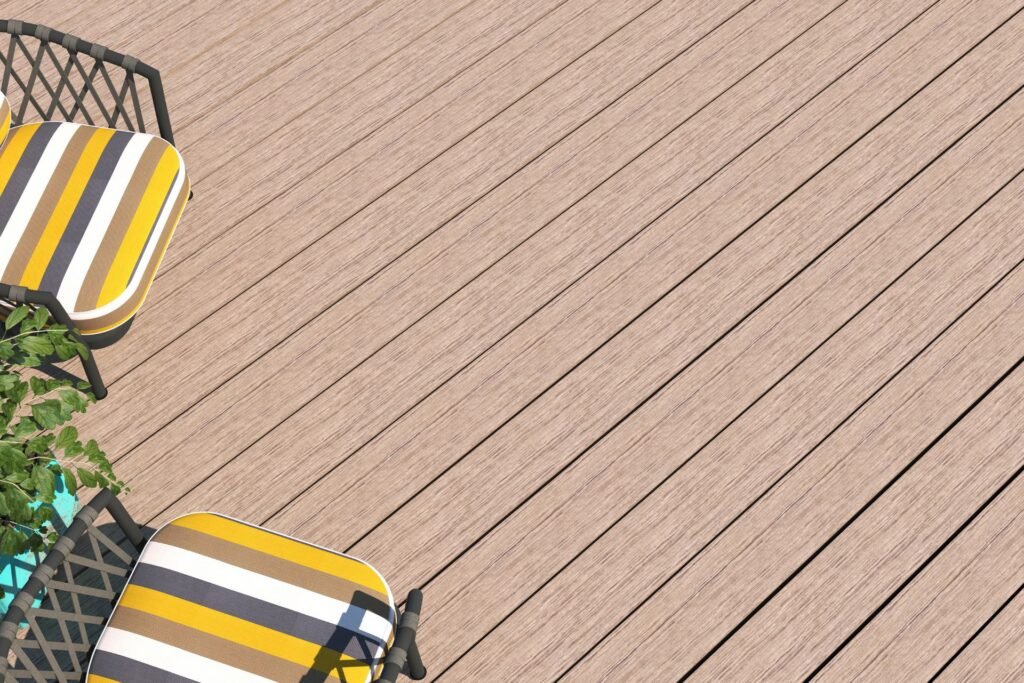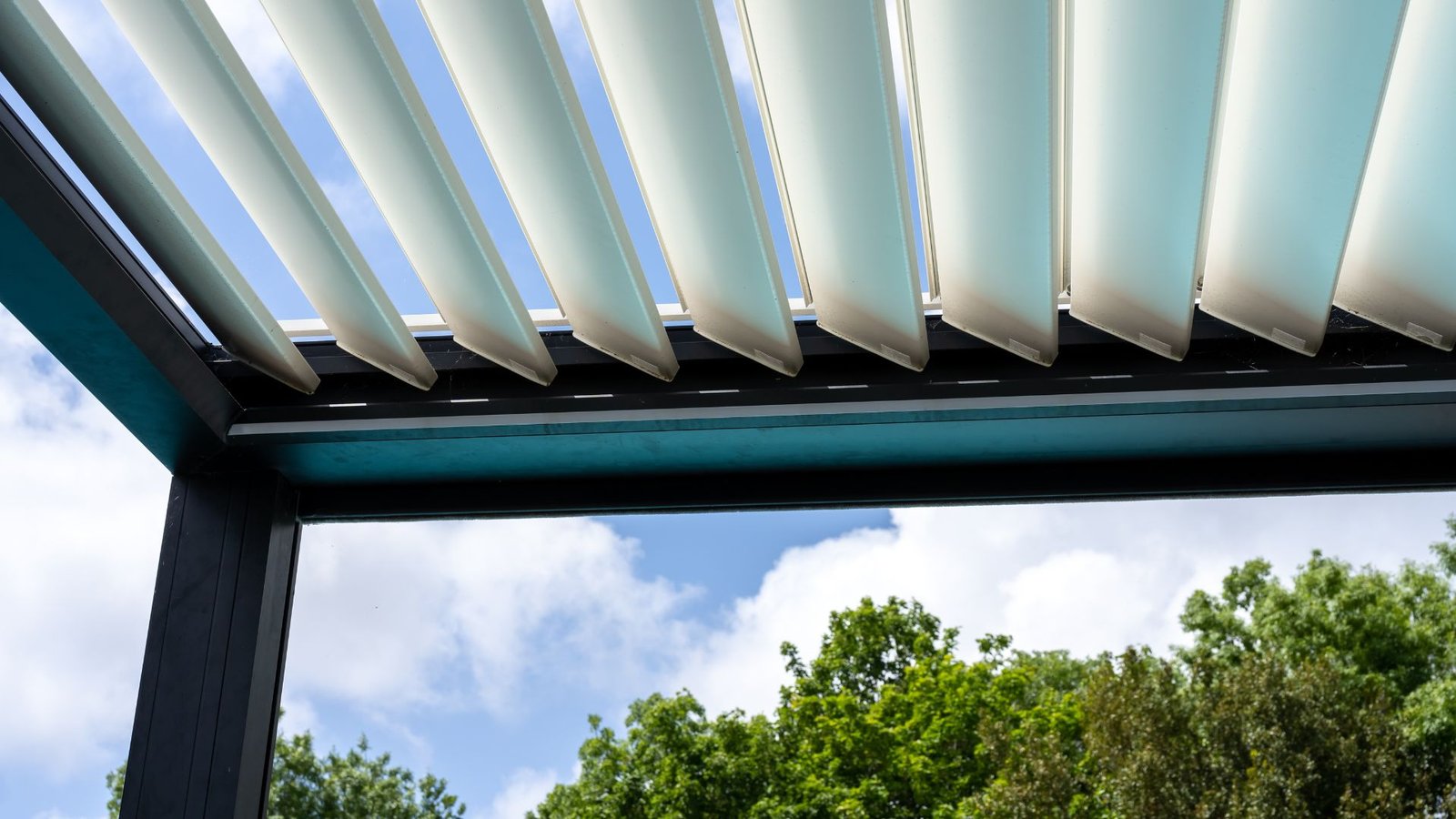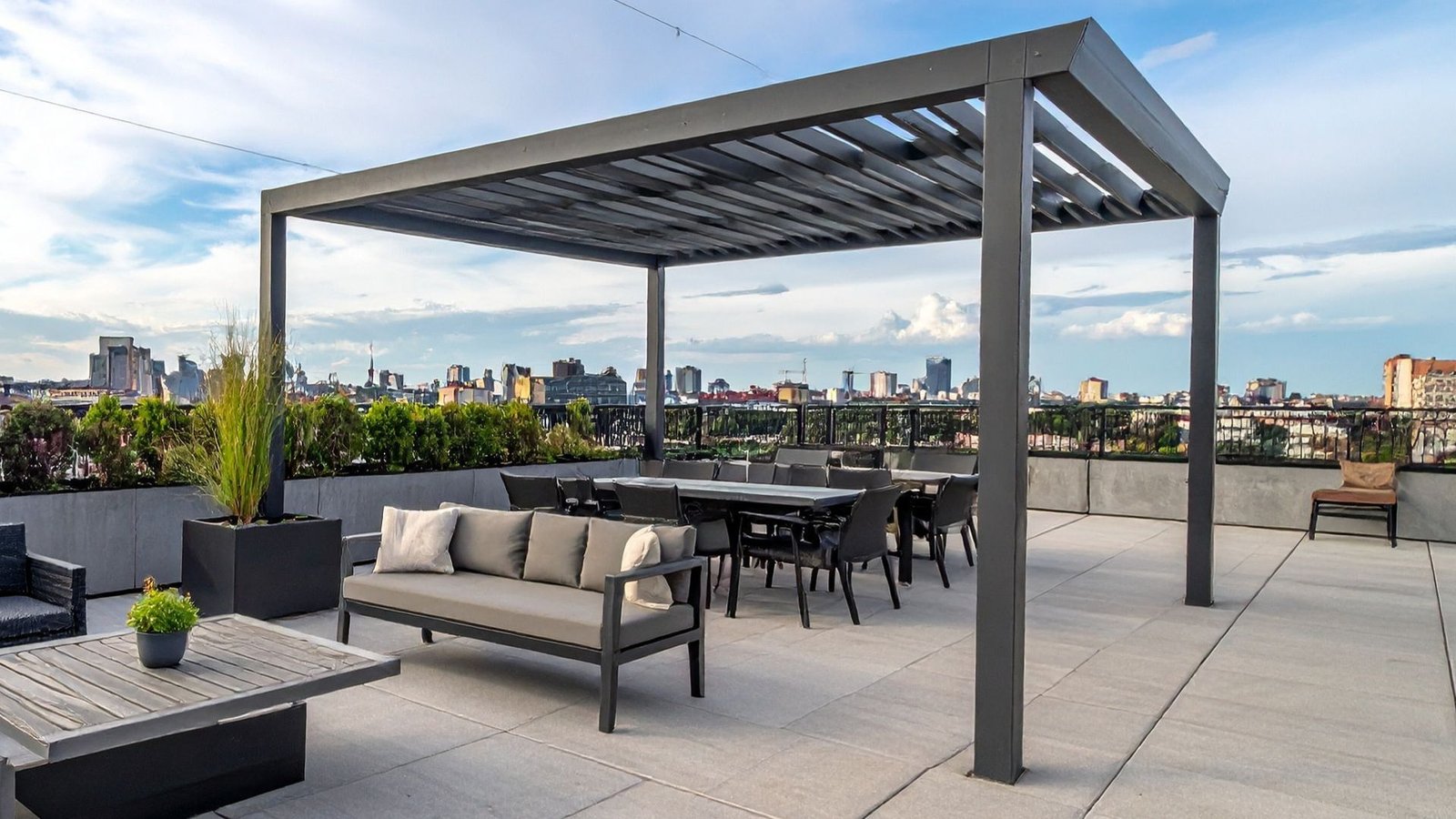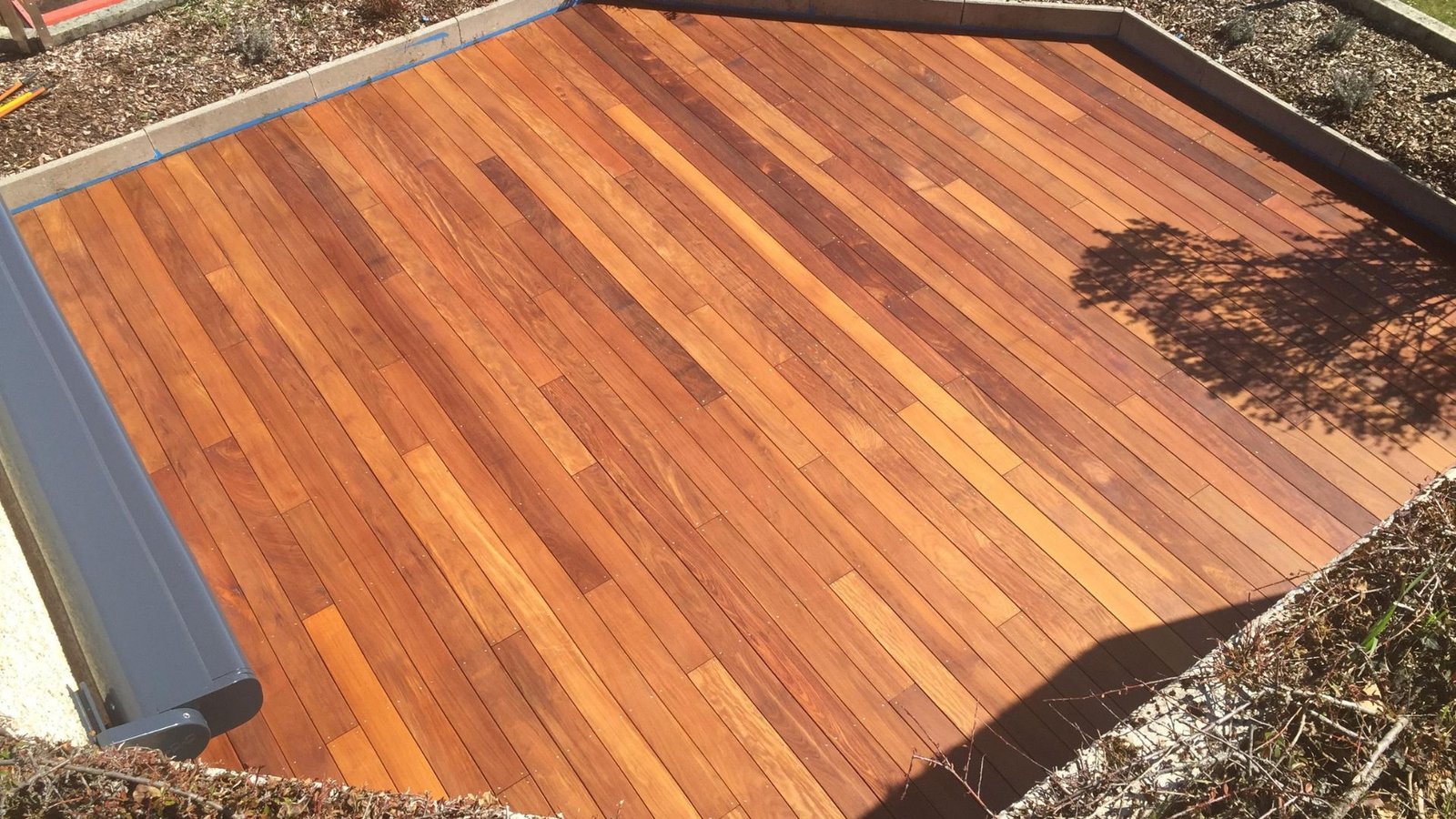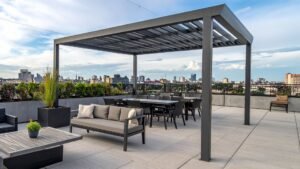Welcome to our comprehensive guide on choosing between timber and composite decking for your New Zealand home. Making the right decision for your outdoor space is crucial, as it impacts not only the aesthetic appeal but also the long-term maintenance and durability of your deck. In this post, we’ll explore the key differences, advantages, and disadvantages of both timber and composite decking, providing you with all the information you need to make an informed choice. Whether you’re looking for the natural beauty of timber or the low-maintenance benefits of composite materials, we’ve got you covered. Read on to discover which decking option suits your needs and lifestyle best.
Timber decking offers natural beauty and versatility but requires regular maintenance and is susceptible to weather damage and pests. Common timber types in NZ include Kwila and Pine. Composite decking, made from a mix of wood fibers and plastic, is low-maintenance and durable, resisting weather and pests, though it comes at a higher initial cost and may not look as natural as timber. Both options have their own environmental impacts, with timber needing sustainable sourcing and composite often made from recycled materials. Choosing the right decking depends on your budget, aesthetic preferences, and willingness to maintain your deck.
Table of Contents
Understanding Timber Decking
Timber decking is a popular choice for outdoor living spaces in New Zealand, offering a blend of natural beauty and practicality. This section delves into what timber decking is, its advantages and disadvantages, and its environmental impact, providing a comprehensive overview for homeowners and builders alike.
What is Timber Decking?
Timber decking refers to outdoor flooring made from wooden planks, providing a natural and aesthetically pleasing surface for patios, verandas, and gardens. In New Zealand, common types of timber used for decking include Kwila, Pine, and Jarrah.
- Kwila: Known for its durability and resistance to decay, Kwila is a dense hardwood with a rich, reddish-brown color. It’s a popular choice due to its longevity and attractive appearance.
- Pine: Treated Pine is a cost-effective option widely available in New Zealand. It’s lighter in color and can be stained or painted to match various design preferences.
- Jarrah: This hardwood is renowned for its strength and fire resistance. Jarrah has a natural resistance to termites and rot, making it a durable option for outdoor decking.
Timber decking has a long history in New Zealand, evolving from simple wooden platforms to sophisticated outdoor living areas. Historically, timber was readily available and easy to work with, making it a go-to material for creating outdoor spaces.
Advantages of Timber Decking
Timber decking offers several benefits that make it a preferred choice for many homeowners:
- Natural Beauty and Aesthetic Appeal: Timber provides a warm, inviting look that blends seamlessly with natural surroundings. Each type of wood has unique grain patterns and colors, enhancing the visual appeal of outdoor spaces.
- Versatility in Design and Customization: Timber can be easily cut, shaped, and stained to fit any design concept. Whether you prefer a rustic look or a sleek modern finish, timber decking can be customized to meet your style preferences.
- Durability and Strength: High-quality timber decking is known for its durability and ability to withstand heavy foot traffic. Hardwood options like Kwila and Jarrah are particularly strong and long-lasting.
Disadvantages of Timber Decking
While timber decking has many advantages, it also comes with some drawbacks that should be considered:
- Maintenance Requirements: Timber decking requires regular maintenance to keep it looking its best. This includes staining, sealing, and occasional sanding to protect the wood from moisture and UV damage.
- Susceptibility to Weather Damage, Pests, and Rot: Timber is prone to weathering, especially in harsh climates. It can also be susceptible to pests like termites and may rot if not properly maintained.
- Higher Long-Term Costs Due to Maintenance: Although timber decking might have a lower initial cost compared to some other materials, the ongoing maintenance can add up over time, making it a more expensive option in the long run.
Environmental Impact
The environmental impact of timber decking is an important consideration for many homeowners:
- Sustainable Sourcing of Timber: Choosing timber from sustainable sources is crucial. Look for certifications such as FSC (Forest Stewardship Council) or PEFC (Programme for the Endorsement of Forest Certification) to ensure the wood is harvested responsibly.
- Carbon Footprint Considerations: Timber is a renewable resource, and using wood products can help reduce carbon emissions. Trees absorb CO2 as they grow, and using wood in construction helps store that carbon for the life of the product. However, the environmental benefits depend on sustainable forestry practices and the lifecycle of the timber product.
In summary, understanding the nuances of timber decking helps homeowners make informed decisions about their outdoor spaces. By weighing the advantages and disadvantages and considering the environmental impact, you can choose the right type of timber decking that meets your needs and aligns with your values.
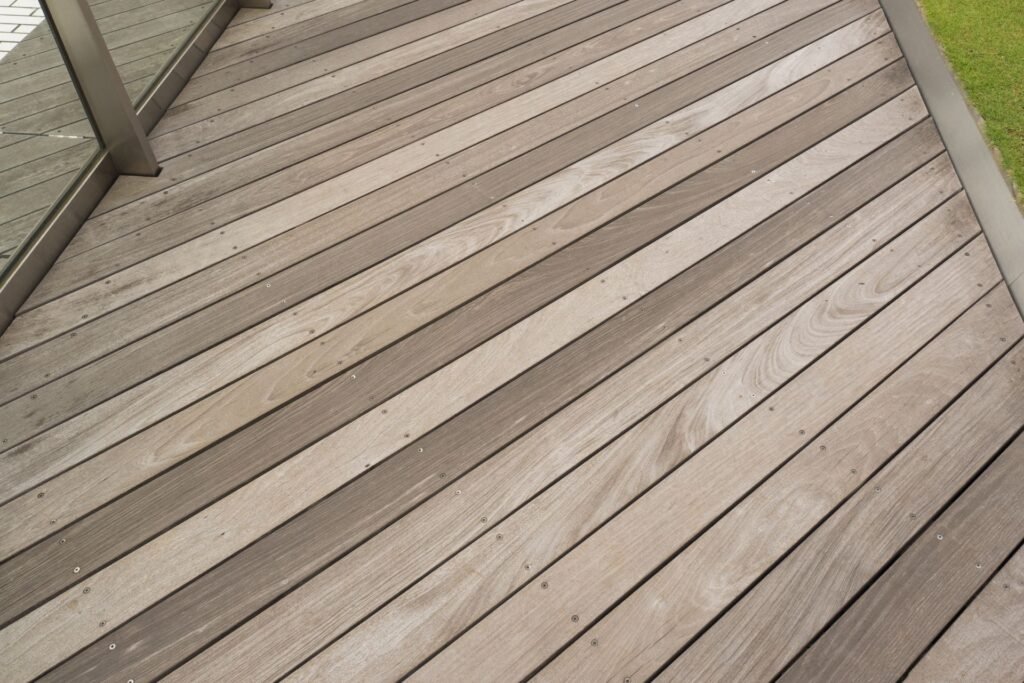
Understanding Composite Decking
What is Composite Decking?
Composite decking is a type of outdoor flooring material that is made from a combination of wood fibers and plastic. This unique composition gives it several benefits over traditional wood decking. The blend typically consists of recycled wood and plastic, which are combined under high pressure to form a durable, long-lasting product.
The concept of composite decking has evolved significantly over the years. Initially introduced as an alternative to wood decking, it has gained immense popularity in New Zealand due to its durability and low maintenance requirements. Homeowners and builders alike appreciate the material’s ability to withstand the harsh weather conditions commonly found in NZ.
Advantages of Composite Decking
One of the primary advantages of composite decking is its low maintenance requirements. Unlike wood, composite decking does not need regular staining, sealing, or painting. A simple wash with soap and water is usually enough to keep it looking good as new. This ease of maintenance makes it an attractive option for busy homeowners who want to enjoy their outdoor spaces without the hassle of constant upkeep.
Composite decking is also highly resistant to weather, pests, and rot. The plastic component of the material helps it to resist moisture and decay, while the wood fibers provide a natural look and feel. This resistance to the elements ensures that composite decking can last for many years without the issues that often plague traditional wood decking.
Another significant advantage is the long-term cost savings. While the initial investment for composite decking might be higher than wood, the reduced need for maintenance and replacement over time often makes it a more economical choice in the long run. Homeowners can save both time and money by opting for a material that requires less upkeep and has a longer lifespan.
Disadvantages of Composite Decking
Despite its many benefits, composite decking does have some disadvantages. One of the main drawbacks is its higher initial cost. The advanced manufacturing process and the quality of materials used mean that composite decking can be more expensive upfront compared to traditional wood options.
There is also the potential for fading and staining. Although composite decking is designed to be durable, it can still be affected by prolonged exposure to the sun and certain substances. Over time, some boards may lose their color intensity or develop stains that can be difficult to remove.
Another limitation is the material’s appearance. While manufacturers have made significant strides in creating more realistic-looking composite decking, it can still lack the natural beauty of real wood. For some homeowners, the slightly synthetic appearance may be a dealbreaker, especially if they are looking to create a more traditional outdoor aesthetic.
Environmental Impact
One of the positive aspects of composite decking is its environmental impact. Many composite decking products are made from recycled materials, including reclaimed wood and plastic. This use of recycled content helps to reduce the demand for virgin materials and can contribute to a more sustainable building practice.
Moreover, the longevity of composite decking means that it does not need to be replaced as frequently as traditional wood decking. This durability leads to less waste over time, as fewer boards end up in landfills. Homeowners who choose composite decking can feel good about their decision, knowing that they are investing in a product that has a smaller environmental footprint.
In conclusion, composite decking offers a range of benefits that make it a popular choice for outdoor flooring in New Zealand. Its low maintenance requirements, resistance to the elements, and long-term cost savings are significant advantages. However, potential drawbacks such as higher initial costs, the potential for fading, and a less natural appearance should also be considered. Despite these downsides, the use of recycled materials and the product’s longevity make composite decking an environmentally friendly option for those looking to create a beautiful and durable outdoor space.

Key Differences Between Timber And Composite Decking
When deciding between timber and composite decking for your outdoor space, understanding the key differences can help you make an informed choice that suits your budget, lifestyle, and environmental values. Let’s dive into the critical aspects that set these two popular decking materials apart.
Cost Comparison
Initial Costs vs. Long-Term Expenses
The initial cost of timber decking is generally lower than that of composite decking. Timber, particularly softwoods like pine, tends to be more affordable upfront. However, hardwoods such as teak or kwila can be more expensive, sometimes rivaling the cost of composite options.
Composite decking, on the other hand, usually comes with a higher initial price tag. This cost difference is due to the manufacturing process, which involves blending recycled wood fibers and plastic. Despite the higher upfront investment, composite decking often proves more economical in the long run. This is because it requires significantly less maintenance, which translates into savings on treatments, sealants, and repairs over time.
Value for Money
When evaluating the value for money, it’s essential to consider both the initial outlay and the ongoing maintenance costs. Timber decking, while cheaper initially, demands regular upkeep. This includes sanding, staining, and sealing to protect it from the elements and prolong its lifespan. Neglecting these tasks can lead to issues like rot, warping, and splintering, which might necessitate costly repairs or replacements.
Composite decking, though pricier at the outset, offers excellent value over time. Its low-maintenance nature means you’ll spend less on maintenance products and labor. Additionally, composites are resistant to rot, insects, and UV damage, ensuring they retain their appearance and structural integrity for years, making them a cost-effective choice in the long run.
Maintenance and Durability
Maintenance Requirements for Both Materials
Timber decking requires a significant amount of maintenance to keep it looking its best. Regular cleaning, staining, and sealing are necessary to protect it from moisture, UV rays, and insects. Depending on the type of timber and the local climate, this can mean annual or bi-annual maintenance. Failure to maintain timber decking can lead to deterioration, reducing its lifespan and aesthetic appeal.
Composite decking, in contrast, is designed to be low maintenance. It typically requires only periodic cleaning with soap and water to remove dirt and debris. Unlike timber, it doesn’t need sanding, staining, or sealing. This makes it an attractive option for homeowners looking for a hassle-free decking solution.
Expected Lifespan and Durability Under NZ Conditions
New Zealand’s diverse climate can be tough on outdoor materials. Timber decking, if well-maintained, can last anywhere from 10 to 30 years, depending on the type of wood used. Hardwoods generally have a longer lifespan than softwoods but still require diligent maintenance to reach their full potential.
Composite decking is engineered to withstand harsh weather conditions and can last 25 to 30 years or more with minimal maintenance. Its durability makes it resistant to rot, splintering, and insect damage, common issues with timber decks. This resilience makes composite decking an excellent choice for New Zealand’s varied climate.
Aesthetic Appeal
Natural Look and Feel of Timber vs. the Modern Look of Composite
Timber decking is often chosen for its natural beauty and warmth. Each piece of timber has unique grain patterns and color variations that can enhance the aesthetic appeal of any outdoor space. The tactile feel of natural wood underfoot is something many homeowners appreciate.
Composite decking has come a long way in mimicking the look of natural wood. Modern composites are available in a wide range of colors and textures, some of which closely resemble real timber. While it may not have the same organic feel as wood, composite decking offers a sleek, contemporary appearance that appeals to many.
Customization Options
Timber decking can be stained or painted in various colors, allowing for a high degree of customization. This flexibility means you can easily change the look of your deck over time to match your evolving tastes or home renovations.
Composite decking also offers a variety of customization options. It comes in numerous colors and finishes, including wood-grain patterns. Some manufacturers even offer composite boards with reversible surfaces, providing different textures or colors on each side, further enhancing your design choices.
Environmental Considerations
Sustainability and Eco-Friendliness of Each Material
When it comes to sustainability, timber decking has both pros and cons. Responsibly sourced timber from certified plantations is a renewable resource, and wood is biodegradable. However, the harvesting process can have significant environmental impacts, including deforestation and habitat destruction if not managed sustainably.
Composite decking is often made from recycled materials, including reclaimed wood fibers and plastics. This reduces the demand for virgin materials and helps divert waste from landfills. However, the manufacturing process is energy-intensive, and composites are not biodegradable. The eco-friendliness of composite decking largely depends on the practices of the specific manufacturer.
Impact on Local Ecosystems
Timber decking can impact local ecosystems, particularly if the wood is not sustainably sourced. Deforestation can lead to habitat loss and a decrease in biodiversity. Additionally, the chemicals used in the treatment of timber to prevent rot and insect damage can leach into the soil and waterways, potentially harming local flora and fauna.
Composite decking, by utilizing recycled materials, can reduce the strain on natural resources and decrease waste. However, it’s important to consider the entire lifecycle of the product. While composites generally have a lower immediate environmental impact than non-sustainable timber, they do not decompose naturally at the end of their lifespan.
In conclusion, both timber and composite decking have their unique advantages and considerations. Your choice will depend on your budget, maintenance preferences, aesthetic desires, and environmental values. By weighing these factors, you can select the decking material that best meets your needs and complements your outdoor living space.
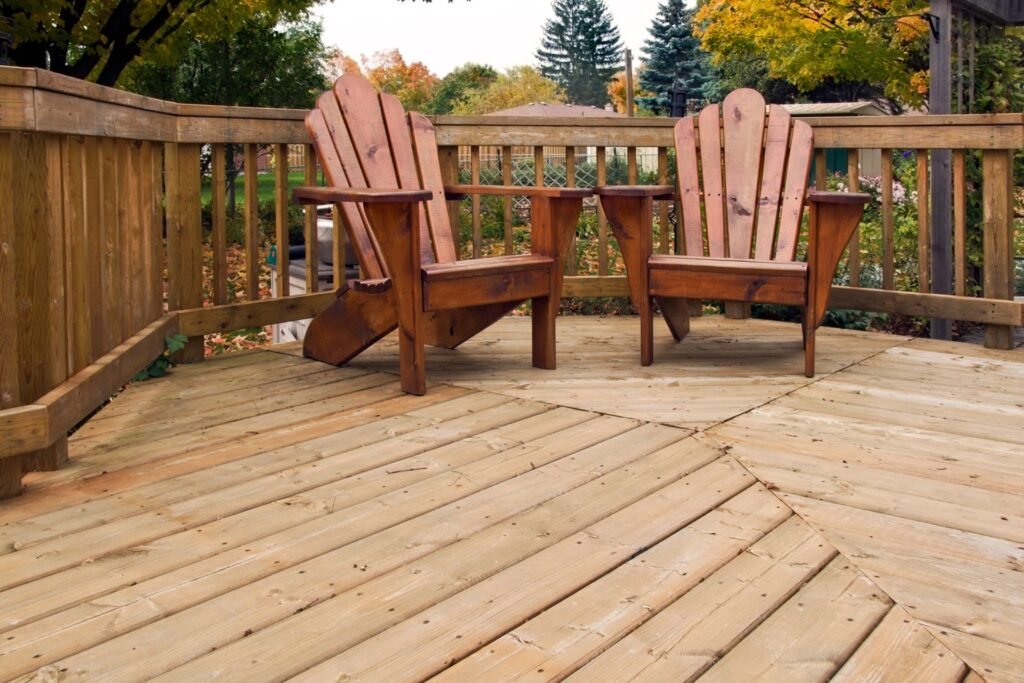
Choosing The Right Decking For Your Home
Selecting the perfect decking for your home involves more than just picking out materials and colors. It’s a comprehensive decision that balances your personal preferences, environmental considerations, and practical aspects such as installation and long-term value. Here’s a detailed guide to help you make an informed choice.
Assessing Your Needs and Preferences
Factors to Consider
- Budget: One of the foremost factors is your budget. Decking materials range from affordable options like pine to premium choices such as hardwood and composite. Determine how much you’re willing to spend and balance that with the quality and longevity you expect from your decking.
- Desired Aesthetics: Your decking should complement your home’s style and your personal taste. Whether you prefer the natural look of timber or the sleek appearance of composite materials, consider how the decking will blend with your existing outdoor space.
- Maintenance Willingness: Different materials require varying levels of maintenance. Natural timber, while beautiful, often needs regular sealing and staining. On the other hand, composite decking tends to be low-maintenance, requiring only occasional cleaning.
Lifestyle and Usage Patterns:
- Family Activities: Think about how your decking will be used. If you have children or pets, you’ll want a durable and slip-resistant surface.
- Entertainment: For those who love to entertain, a spacious, comfortable decking area with enough room for furniture and guests is essential.
- Relaxation: If your goal is a tranquil outdoor retreat, consider features like built-in seating, pergolas, or even space for a hot tub.
Climate and Environmental Factors
How NZ’s Climate Affects Decking Choices
- Sun Exposure: New Zealand enjoys a lot of sunshine, which can fade certain decking materials over time. UV-resistant options like some composites can be a good choice to keep your deck looking fresh.
- Temperature Fluctuations: Rapid changes in temperature can cause some materials to expand and contract, potentially leading to warping or cracking. Composite decking often handles these fluctuations better than natural wood.
Specific Regional Considerations
- Coastal Areas: For homes near the coast, choosing materials that resist saltwater corrosion and high humidity is crucial. Marine-grade timber or specially treated composites can withstand these harsh conditions.
- Heavy Rainfall: In regions with high rainfall, proper drainage is vital to prevent water accumulation that can lead to rot and mold. Materials like composite decking, which are less susceptible to moisture damage, might be ideal.
Installation Considerations
DIY vs. Professional Installation:
- DIY Installation: If you have the skills and tools, installing your own decking can be a rewarding project. It allows for customization and can save on labor costs. However, it requires a good understanding of construction principles and a significant time investment.
- Professional Installation: Hiring professionals ensures the job is done correctly and efficiently. They have the expertise to handle complex designs and can often complete the project faster than a DIY approach. This option is particularly beneficial for large or intricate decks.
Time and Labor Involved
- DIY Projects: Be prepared for a time-consuming process. From preparing the site to the final finishing touches, DIY decking can take several weekends to complete.
- Professional Projects: While more costly upfront, professional installations are usually quicker. You also benefit from their experience, which can prevent costly mistakes and ensure a high-quality finish.
Long-term Value and Resale Potential
Impact on Property Value
- Enhanced Aesthetics: A well-designed deck can significantly boost your home’s curb appeal, making it more attractive to potential buyers. The right choice of materials and design can set your property apart in the market.
- Functional Space: Additional outdoor living space is a major selling point. It adds to the usable area of your home, offering potential buyers more options for entertaining and relaxation.
Future-proofing Your Investment
- Durability: Investing in high-quality materials can save money in the long run. Durable options like hardwood or composite decking have a longer lifespan and require less frequent replacement or repair.
- Low Maintenance: Future buyers will appreciate a deck that doesn’t require constant upkeep. Low-maintenance materials can be a strong selling point, highlighting the practicality and ease of living in your home.
Choosing the right decking involves careful consideration of your personal needs, the environmental conditions of your area, and practical aspects like installation and long-term value. By weighing these factors, you can make a well-informed decision that enhances your home and lifestyle.
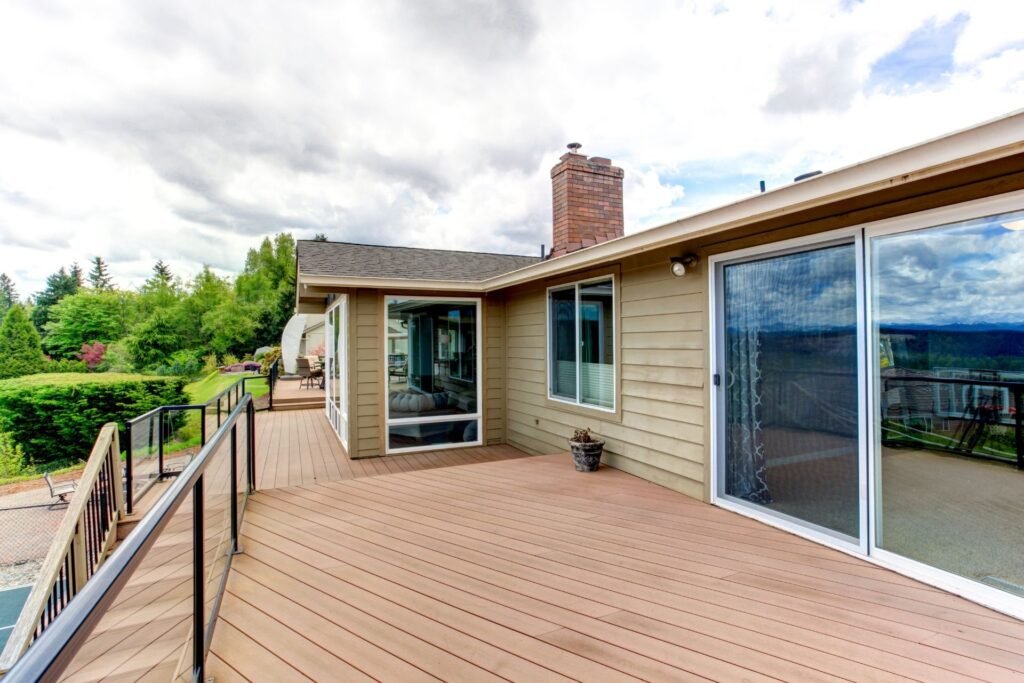
Real-Life Case Studies And Testimonials
Case Study 1: A Timber Deck in Auckland
In the bustling city of Auckland, Jane and Mike decided to enhance their outdoor living space with a beautiful timber deck. They wanted a natural look that blended seamlessly with their garden and provided a warm, inviting space for family gatherings.
Homeowner’s Experience
Jane and Mike found the process of building their timber deck to be relatively straightforward. They chose a local contractor known for quality craftsmanship and eco-friendly practices. The initial consultation involved discussing their vision, selecting the type of timber, and understanding the maintenance requirements. They opted for Kwila, a popular choice in New Zealand for its durability and rich color.
Costs
The total cost for their timber deck, including materials and labor, came to around NZD 15,000. This included the price of the timber, which was approximately NZD 10,000, and labor costs, which amounted to NZD 5,000. Additional expenses included treatments to protect the wood from Auckland’s varying weather conditions.
Satisfaction
Jane and Mike were thrilled with the outcome. The deck not only added value to their home but also provided a perfect spot for BBQs and family events. They appreciated the natural aesthetics and the warmth of the timber. Regular maintenance, such as annual staining and sealing, was a small trade-off for the beauty and longevity of their deck.
Case Study 2: A Composite Deck in Wellington
Down in Wellington, Emma and John wanted a low-maintenance solution for their outdoor area. They decided on a composite deck, which offered the look of wood without the extensive upkeep.
Homeowner’s Experience
Emma and John’s experience was highly positive. They worked with a reputable decking company that specialized in composite materials. The project began with a consultation to discuss design preferences and color options. They selected a modern grey composite that complemented their home’s exterior.
Costs
The composite deck cost them around NZD 20,000. The material was slightly more expensive, with the composite boards costing about NZD 12,000. Labor costs were higher as well, totaling NZD 8,000 due to the precision required in installation. However, they viewed this as an investment in convenience and long-term durability.
Satisfaction
Emma and John were extremely satisfied with their choice. The composite deck was not only visually appealing but also required minimal maintenance. There was no need for staining or sealing, and the deck remained resistant to Wellington’s windy and wet climate. They enjoyed spending time outdoors without worrying about the deck’s upkeep, making it a worthwhile investment.
Expert Opinions
To provide a well-rounded perspective, we consulted several builders and designers across New Zealand for their insights into timber and composite decking.
Insights from Builders
According to Tom, a builder with over 20 years of experience, timber decks are a favorite for their natural beauty and the character they add to homes. However, he emphasizes the importance of regular maintenance to prevent weather damage and extend the deck’s life.
On the other hand, Sarah, another experienced builder, highlights the growing popularity of composite decks. She notes that while the initial cost is higher, the long-term savings on maintenance make it an attractive option. Composite decks are especially recommended for busy homeowners who want a hassle-free outdoor space.
Designer Perspectives
Lisa, a landscape designer, often recommends timber decks for clients seeking a traditional and organic feel. She believes that timber’s natural variations and warmth cannot be fully replicated by composites. However, for modern and contemporary designs, she finds composite decking to be more suitable due to its sleek appearance and wide range of color options.
Overall, both timber and composite decks have their own set of advantages. The choice ultimately depends on the homeowner’s preferences, budget, and willingness to commit to maintenance. Real-life case studies and expert opinions collectively highlight that with the right planning and execution, either option can significantly enhance an outdoor living space in New Zealand.

FAQs: About Timber Vs Composite Decking NZ
What are the main differences between timber and composite decking?
Timber decking is made from natural wood, offering a classic look and feel, while composite decking is a blend of wood fibers and plastic, known for its durability and low maintenance. Timber requires regular upkeep and is prone to weather damage and pests, whereas composite is resistant to these issues but can be more expensive initially.
What types of timber are commonly used for decking in New Zealand?
Common types of timber used for decking in New Zealand include Kwila, Pine, and Jarrah. These woods are chosen for their durability, aesthetic appeal, and suitability to the local climate.
How does the cost of timber decking compare to composite decking?
Timber decking generally has a lower initial cost compared to composite decking. However, timber may incur higher long-term costs due to maintenance, repairs, and replacements. Composite decking, while more expensive upfront, typically requires less maintenance and has a longer lifespan.
What kind of maintenance does timber decking require?
Timber decking requires regular maintenance, including staining, sealing, and periodic cleaning to protect against weather damage, rot, and pests. This upkeep is necessary to maintain its appearance and structural integrity.
Is composite decking environmentally friendly?
Composite decking can be environmentally friendly, especially when made from recycled materials. It has a long lifespan, reducing the need for frequent replacements and minimizing waste. However, it’s important to choose brands that prioritize sustainable practices.
How long does timber decking last compared to composite decking?
The lifespan of timber decking can vary based on the type of wood and maintenance, typically ranging from 10 to 15 years. Composite decking generally lasts longer, often up to 25-30 years, due to its resistance to weather, pests, and rot.
Which decking material is better for coastal areas in NZ?
Composite decking is usually better suited for coastal areas in New Zealand due to its resistance to moisture, salt, and pests. Timber decking can still be used but requires more diligent maintenance to protect against the harsher coastal environment.
Can I install decking myself, or should I hire a professional?
Both timber and composite decking can be installed as DIY projects if you have the necessary skills and tools. However, hiring a professional can ensure proper installation, adherence to building codes, and potentially longer-lasting results.
How does decking affect the resale value of my home?
Well-maintained decking can enhance the aesthetic appeal and functionality of outdoor spaces, potentially increasing the resale value of your home. Composite decking, due to its durability and low maintenance, may offer a higher return on investment in the long run.
What are the aesthetic differences between timber and composite decking?
Timber decking offers a natural, warm appearance with unique grains and knots, appealing to those who prefer a classic look. Composite decking, while available in various colors and textures, may not look as natural but provides a more uniform and modern appearance. The choice ultimately depends on personal preference and the desired aesthetic for your outdoor space.
Conclusion
To wrap up, it’s important to recap the key points about timber and composite decking. Timber decking offers a natural, classic look with a lower initial cost but requires regular maintenance to prevent weathering and decay. In contrast, composite decking, while more expensive upfront, is low-maintenance and durable, making it a cost-effective option over time. For those with budget constraints, timber might be the preferred choice, whereas those prioritizing longevity and minimal upkeep might lean towards composite decking. Ultimately, your decision should align with your budget, aesthetic preferences, and willingness to maintain your deck. As you consider your options, consult with decking professionals to ensure you make the best choice for your specific needs. We’d love to hear about your decking experiences and any questions you have, so feel free to share in the comments section below.
About the Author:
Mike Veail is a recognized digital marketing expert with over 6 years of experience in helping tradespeople and small businesses thrive online. A former quantity surveyor, Mike combines deep industry knowledge with hands-on expertise in SEO and Google Ads. His marketing strategies are tailored to the specific needs of the trades sector, helping businesses increase visibility and generate more leads through proven, ethical methods.
Mike has successfully partnered with numerous companies, establishing a track record of delivering measurable results. His work has been featured across various platforms that showcase his expertise in lead generation and online marketing for the trades sector.
Learn more about Mike's experience and services at https://theleadguy.online or follow him on social media:

